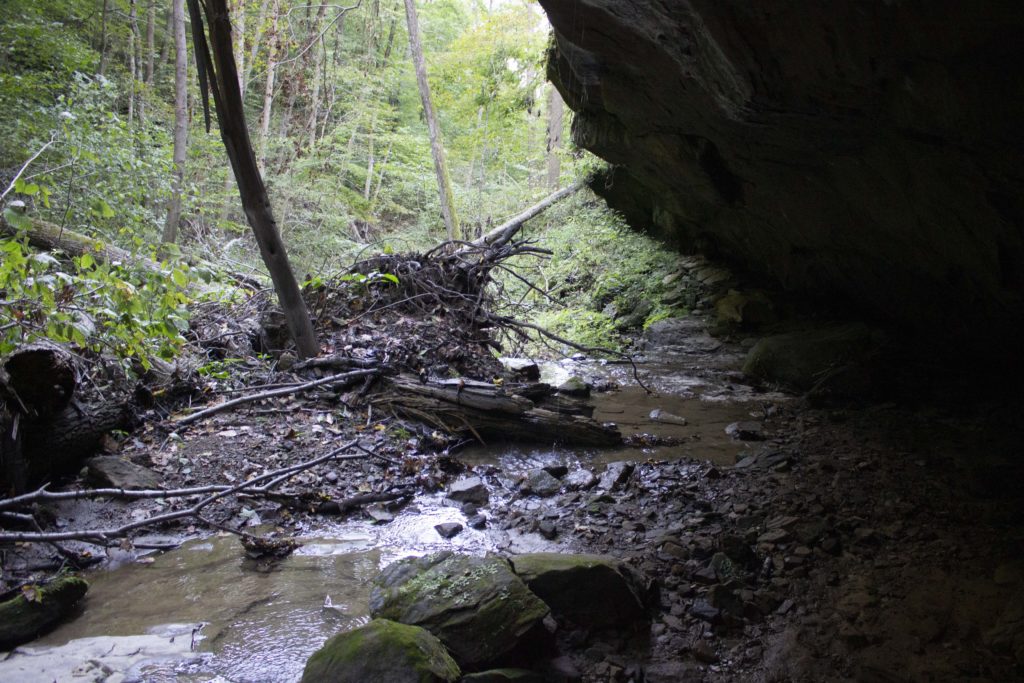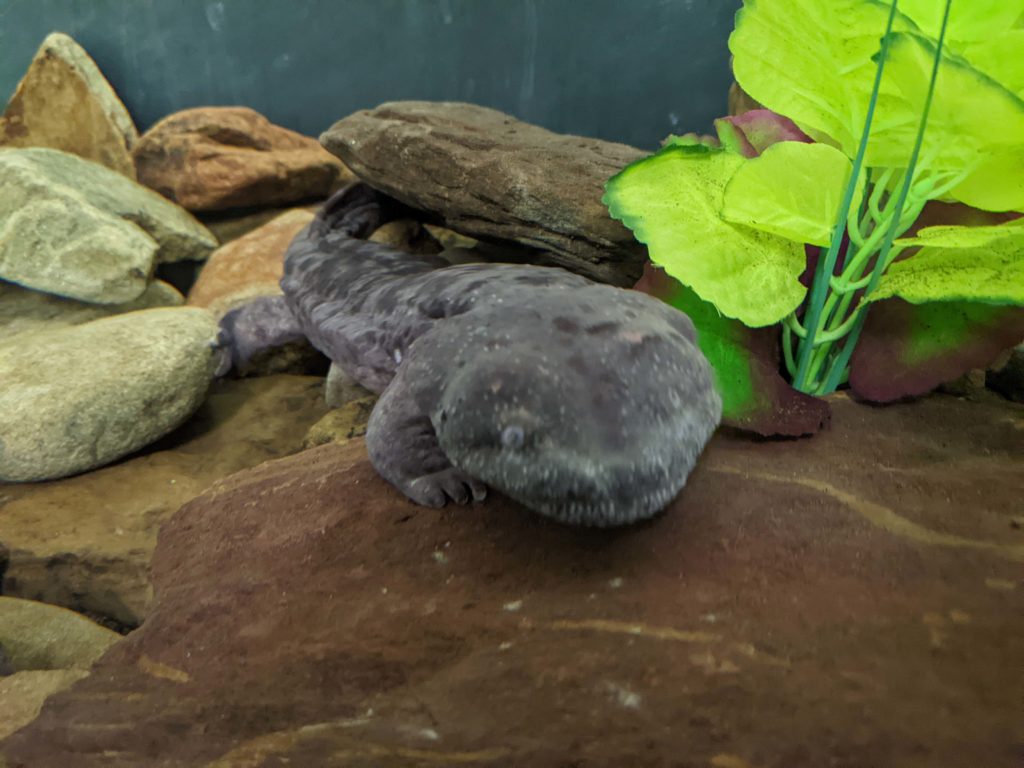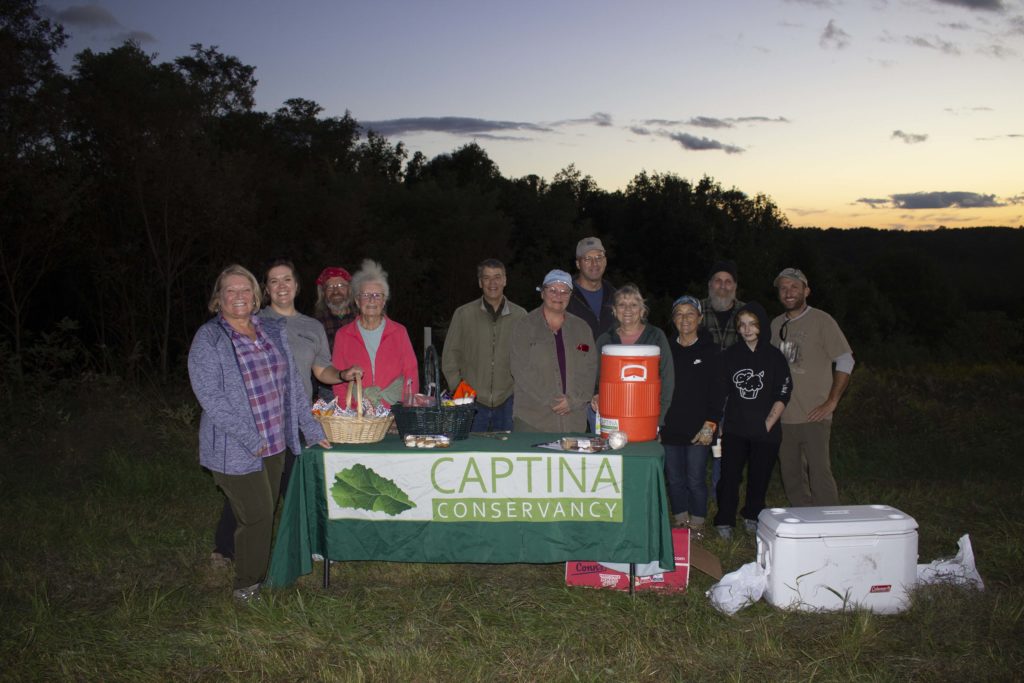
Captina Conservancy members during hike at Rock River Refuge.
Something lurks in the waters of southern Belmont; it has a flat spade-shaped body that can grow to two feet long, small beady eyes that look like pen pricks through a sheet of black paper, slimy rock patterned skin that sucks oxygen out of the water and a wide gaping mouth inviting to small fish. But rather than horror, the Eastern Hellbender salamander invites a certain curiosity to the waters of the Captina Creek Watershed, one of the most pristine groupings of waters in Ohio. It is so striking that local members have taken up the cross of protecting its habitat, forming the Captina Conservancy.
“They’re kind of a unique animal,” Ron Preston, an honorary board member of Captina Conservancy and former aquatic biologist, says. “It captures the imagination of a lot of people to see that big salamander.”
Sometime in the late 2000s, Greg Lips began research on the hellbender population in Captina Creek Watershed. Lips is a herpetologist, someone who studies amphibians and reptiles. With the help of teachers and students at Olney Friends School, plus local and state environmental agencies, he surveyed the region, steadily spreading awareness of the salamander. This study came to a head in 2010 when the Ohio Environmental Protection Agency did a comprehensive survey of the Captina Creek Watershed. They found it possessed outstanding state water based on exceptional ecological values.
Preston says the community quickly became concerned with maintaining the health of Captina Creek Watershed. They pitched possible actions during a series of meetings hosted by Belmont County Soil and Water Conservation District in 2010. Finally, Lips suggested the community form a conservation agency.
Thus, Captina Conservancy came to be founded in 2010 as a non-profit land trust. Its primary method of environmental protection is conservation easement: a voluntary agreement signed with a private landowner restricting development of the land.
“Once they’re signed, they get recorded on the deed to the property, then they apply to everyone who owns the property after that,” Ellie Ewing, the executive director of Captina Conservancy, says “So, if someone inherits it or it’s sold, that agreement applies no matter what.”
Ewing says that the terms of the easement vary depending on the landowner. The most common stipulation prevents the land from being divided and sold in small parcels. Another common stipulation limits the construction of structures on the property to two units. Combined, these restrictions discourage large-scale housing development on the property, which can be damaging to Captina Creek Watershed. Restrictions on clear cutting and maintaining water quality are also present. These measures help restrict the flow of sediment into the water.
Sediment is particularly damaging as it can prevent aquatic life from absorbing oxygen in the water. Preston says one primary concern for the watershed is oil and natural gas pipelines. Not because they risk leaking pollutants into the water, but because they risk dislodging sediment into the water.
Captina Creek Watershed has so far escaped this fate due to its heavy forest coverage preventing sediment drainage.
“Wherever you have a significant amount of forest cover in the watershed, the stream maintains itself in a pretty good high-quality water,” Preston says. “So, somewhere in the range of 60 to 70% of the watershed being forested is typical of high-quality streams, especially in Southeast Ohio.
Hellbenders are extremely sensitive to water quality. The water must have the right mixture of dissolved oxygen, temperature, pollutant density and flowrate. Captina Creek Watershed is the only watershed in Ohio with a population of juvenile hellbenders.
“In other watersheds they may have very old hellbenders or very young, but they aren’t surviving through to become juveniles like they are here,” Ewing says.
Captina Conservancy’s easement projects have been so successful they have extended beyond the original watershed. Ewing says the conservancy has been approached by landowners in Monroe, Harrison and Jefferson counties.
Landowners normally come out of their own volition after learning about Captina Conservancy through its educational outreach programs. Preston says these landowners are primarily seeking to protect property or farmland that has been in their family for generations. Through a conservation easement they can protect the land from development, even if it ends up outside familial ownership. However, not every perspective property obtains an easement.
“For every three or four landowners that approach us and are interested, we may end up with only one or two conservation easements in the end,” Ewing says.

Rock River Refuge is an example of one of these properties. Rock River Refuge was donated to the Captina Conservancy by Wayne Mayson in 2015 and is located in southwestern Belmont County. Wayne had purchased the property in the 1990s with the intent of maintaining the natural resources there.
Rock River Refuge covers approximately 200 acres of land. It is formed primarily of forest and reclaimed farmland. Its opening is dotted with white pipes protecting native trees from the rough tongues of curious deer. The Captina Conservancy maintains a hiking trail and small gathering site open to the public at Rock River Refuge. Ewing says one goal of Captina Conservancy is to make sure donated lands still serve a function to the public.
We really seek to balance that mission of protecting and preserving property with also providing public access, because when you preserve property, you’re locking it up from development, it can’t be used by as many people,” Ewing says. “So we try to balance that with making public spaces that are available for use by people in a sustainable and protected way.”
A Slimy Representative

Captina Conservancy has one unique member, Named Marvin, she is an Eastern Hellbender donated to the conservancy in 2021 by the late herpetologist Ralph Pfingsten. For most of her life, she was assumed to be a male. It was not until Marvin received blood work that she was discovered to be female. However, the name Marvin had been around too long to be changed.
Marvin is currently the oldest domestic hellbender that is known. She is estimated to be over 40 years old and kept in a tank at the Captina Conservancy headquarters in Barnesville. Those who visit the Captina Conservancy’s Facebook page, Friends of Captina Creek, will be treated to short videos of Marvin lazily meandering around the rocks in her tank.
She’s immobile and log-like, emanating that languid aura which most cold-blooded creatures possess.
A Community Organization

Aside from protecting the watershed, the Captina Conservancy is a strongly community-oriented organization. Captina Conservancy hosts various community events throughout the year. There is a wildflower hike with a focus on plant identification. There is also a duck dash, an event where rubber ducks can be purchased and raced down a river for cash prizes.
A group like this requires an A-team of members. Even worse, it requires an A-team of members who donate their time for free. Afterall, Captina Conservancy only has one paid member with the rest being volunteers. Luckily, community members have stepped up to fill the need.
Sylvia Bowen is a walking lexicon of herbal knowledge. With long gray hair tied in a bun, glasses, a teal windbreaker and a boisterous personality, she is an integral member of the Captina Conservancy. During hikes she can be seen investigating various plant life and gathering others around her to explain the mysteries of the herb in her hand.
During a hike at Rock River Refuge, Bowen informed participants on the plant’s native to the area. There was Goldenrod, a tall, yellow-flowered plant that used to synthesize artificial rubber. There was Indian Hemp, a thick, fibrous plant used by Native Americans to make rope. She passed around leaves of spicebush, which when crumpled up in the hand released a strong mint-like fragrance.
Gary Wershing, a board director for Captina Conservancy, acts as something of a local historian for the conservancy. He is a tall man with a long beard and thick shoulders due to his career as a blacksmith. Wershing owns property adjacent to Rock River Refuge and used to walk the property with his kids before it turned into a hiking trail. He pointed at different clearings and recollected the different farm structures and pastures that once dotted the land. “Somebody said there was still in every one of these hallows at one time,” Wershing says.
The Captina Conservancy demonstrates that the local population is not distinct from the environment. In fact, inconspicuous decisions made, such as building a new barn or shed, can damage the local aquafauna, preventing future generations from witnessing the grandeur of nature in the form of a hellbender. It takes dedicated effort to preserve the area for future generations.